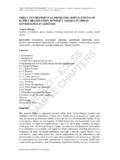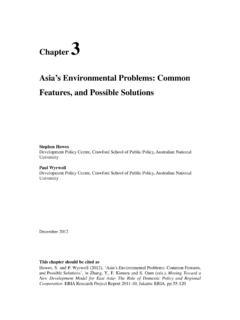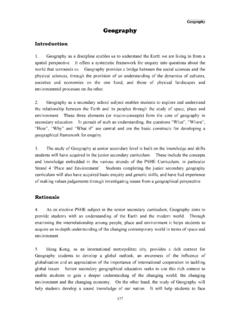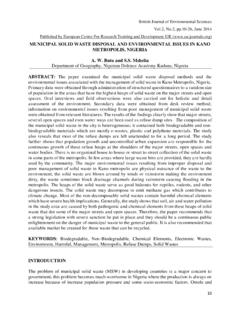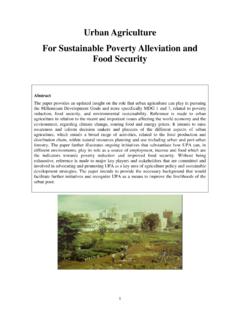Transcription of Working Paper Connected Urban Growth: Public …
1 Urban Growth: Public - private Collaborations for transforming Urban MobilityDiego Canales, Shannon Bouton, Elaine Trimble, Julia Thayne, Larissa Da Silva, Srikanth Shastry, Stefan Knupfer and Martin PowellWorking PaperExecutive Summary Innovative, technologically sophisticated operators of ride-hailing networks, car- and bicycle-sharing systems, mobile trip-planning and ticketing apps, and other new mobility services are winning users in cities around the world. Their reception suggests that city dwellers need transport options that are more convenient and flexible than those offered by traditional private transport companies and Public transit agencies. Public transit is a vital element of efficient Urban transportation systems: the use of Public transportation has grown steadily since 2001, with developing countries showing the fastest growth. However, many Public transit systems face challenges such as rising costs, ageing assets, and rapidly increasing ridership.
2 While private transportation services have given passengers appealing options in many cities, these services can also exacerbate problems related to safety, environmental quality, and other new mobility services proliferate, cities will have opportunities to influence their roles so they not only improve convenience for passengers but also create wider economic and environmental benefits for all city residents. One approach, which some 70 cities worldwide have taken, is to form partnerships that allow cities to use the distinctive features of new mobility services to improve their transportation systems overall. Evaluating the possibilities associated with this approach requires an understanding of the development of new mobility services in cities around the world, the partnerships that have been formed to date, and the economic and environmental implications of complementing Public transit with new mobility models. EXECUTIVE SUMMARY 1 INTRODUCTION 5 PART 1: THE EVOLUTION OF MASS TRANSIT AND private mobility SERVICES 6 PART 2: ECONOMIC AND ENVIRONMENTAL IMPACT ASSESSMENT OF SPECIFIC APPLICATIONS 17 PART 3: CONSIDERATIONS FOR POLICYMAKERS 29 ANNEX: METHODOLOGY FOR THE GLOBAL SCAN OF NEW mobility SERVICES 31 CONTENTSPageThe McKinsey Center for Business and EnvironmentConnected Urban Growth.
3 Public - private Collaborations for transforming Urban mobility 2 About this Working paperThis Working Paper was prepared for the Coalition for Urban Transitions, a special initiative of the New Climate Economy for this Paper was conducted as part of the Urban mobility workstream, co-led by the WRI Ross Center for Sustainable Cities, Mckinsey Center for Business and Environment, and Siemens. Working papers contain preliminary research, analysis, findings, and recommendations. They are circulated to stimulate timely discussion and critical feedback, and to influence ongoing debate on emerging issues. Working papers may eventually be published in another form and their content may be revised. This work is independent, reflects the views of the authors, and has not been commissioned by any business, government or other material has been funded by UK aid from the UK government; however, the views expressed do not necessarily reflect the UK government s official , D.
4 , Bouton, S., Trimble, E., Thayne, J., Da Silva, L., Shastry, S., Knupfer, S., Powell, M. Connected Urban Growth: Public - private Collaborations for transforming Urban mobility . Coalition for Urban Transitions. London and Washington, DC. Available at: Coalition for Urban Transitionsc/o World Resources Institute10 G St NESuite 800 Washington, DC 20002, USA+1 (202) 729-7600C40 Cities Climate Leadership GroupNorth West Entrance, City-Gate House39-45 Finsbury Square, Level 7 London EC2A 1PX, United Kingdom+44 (0) 20 7922 0300 Photo credit: Visty BanajiWRI Ross Center for Sustainable Cities10 G St NESuite 800 Washington, DC 20002, USA+1 (202) 729-7600 This work is licensed under the Creative Commons Attribution International License. To view a copy of the license, visit Working Paper presents a Working definition of the term new mobility services, which encompasses a broad set of emerging operating models and technologies that are intended to improve the performance of Urban transportation systems.
5 It also presents the first global survey of new mobility services, and identifies emerging trends and opportunities for decision-makers in both the Public and private sectors. More than half of new mobility start-ups fall into the shared mobility category, and every region of the world has homegrown companies of this kind (Figure ). While shared mobility services include familiar varieties such as mass transit and taxi services, the newest ones are defined by their use of data and technology to streamline the dispatching and tracking of trips, as well as the user experience, from arranging the service to paying for it. Start-ups in a second category of new mobility services product innovation mostly concentrate on the development of self-driving vehicles and electric ES1 More than half of new mobility start-ups fall into the shared mobility category* The aggregate number of service providers in each category is less than the sum of the regional counts of service providers because many service providers operate in multiple regions.
6 For the aggregate column, each of these service providers is counted only : AngelList, CrunchBase, authors analysis, August AmericaConsumer experienceProduct innovationData-drivendecision makingShared mobilityLatin AmericaEuropeAfricaAsiaOceaniaAggregrate *151294720473936574622008266651514319248 51698202834115771029136281229 Connected Urban Growth: Public - private Collaborations for transforming Urban mobility 4In the consumer experience category, 70% of start-ups specialise in the analysis and provision of information about Public transport, an enterprise that has been greatly aided by the trend of governments providing open access to their data on transit system operations. The remainder of consumer experience start-ups offer services that allow the planning and ticketing of Urban journeys that use multiple modes of transport. Finally, start-ups in the data-driven decision-making category analyse data from multiple parts of Urban transit systems to help transportation agencies make better choices about management, planning, and operations.
7 Perhaps because new mobility services are diverse and novel, there is not yet an obvious formula for how cities can maximise the benefits of these services while mitigating their societal costs, such as worsening traffic congestion or added air pollution. But it is clear that the arrangements that cities establish between their transit agencies and the providers of new mobility services will be critically important. Figure ES2 Three new mobility applications have the potential to make Public transportation more attractive and competitiveApplication 1: Dynamic trip-planning and ticketing servicesPurpose: Encourage city dwellers to take multimodal journeys by enhancing access to information and simplifying ticket : Increased transit ridership; lower environmental impats Mechanism: Technology platform, accessed with a mobile app, that integrates information and processes payments and model: City transit agencies use third-party technology or contract with service 2: On-demand minibusesPurpose: Streamline mass-transit systems by matching service levels more closely to : Lower operating costs; easier access to transportation; lower environmental : Fleet of electric minibuses, hailed using a mobile app, replaces underused fixed-route services.
8 Partnership model: City transit agencies use third-party technology or contract with service providers to run fleets. Application 3: First- and last-mile ride sharingPurpose: Broaden access to transportation for underserved city : Increased transit ridership and utilization; lower system-operating costs; expanded transit : Subsidies paid to passengers for on-demand shared rides from areas with poor transit access to transit hubs. Partnership model: City transit agencies contract with ride-hailing companies to provide shared Paper identifies three promising applications of new mobility services by Public transit agencies (Figure ), and presents economic, social, and environmental modelling that illustrate the value of such partnerships to mass transit application consists of services that let consumers plan multimodal journeys based on dynamically updated information and to purchase the tickets that these journeys require. In another application, transit agencies rely on on-demand mobility services to offer Public transit riders a mode of transport that is more flexible and cost-effective than fixed-route buses and subways.
9 And a third application involves subsidising passengers use of ride-sharing services to make short trips to and from Public transit stops in neighbourhoods that have limited transit access. Although the results of existing new mobility applications have not been widely shared, simulating these three applications in London, Mexico City, and San Francisco suggests that they could have economic and environmental benefits. Dynamic trip-planning and ticketing systems and on-demand minibus services would each require modest up-front investments that could be paid back within two years by reductions in operating costs. Subsidising the use of ride-sharing services for first- and last-mile trips to and from transit hubs can boost mass-transit ridership and generate more farebox revenues with no initial capital outlay. Further modelling of these three new mobility applications indicates that they could offer significant environmental benefits. Dynamic trip-planning and ticketing apps could cut greenhouse gas (GHG) emissions by 500,000 tonnes per year in 2020 across the three cities, as more people use Public transportation, with Mexico City benefiting most.
10 Total emissions from transportation across the three cities could be reduced by up to 6%. Replacing fixed-route diesel buses with on-demand electric minibuses could yield improvements as well: in Greater London, GHG and fine-particulate (PM10) emissions could be cut by more than 80% and nitrogen oxide (NOx) emissions by up to 95% per bus route, while San Francisco could see even larger reductions. Deploying ride-sharing services for first- and last-mile trips to and from Public transportation stops, which enables more people to use mass transit instead of their cars, could reduce per-journey emissions of GHGs and local air pollutants by 55 80%. Finally, this Paper outlines several practices that can help cities make good use of new mobility applications to enhance the overall efficiency and experience of Urban transportation systems. These include: establishing consistent policies on data security and sharing; compiling open datasets on their transportation systems; setting targets for the performance of transportation systems that reflect larger policy priorities; continuously assessing the economics of mass transit so as to pinpoint opportunities to boost efficiency; forecasting and preparing to manage effects on employment; and balancing short-term improvements to transportation systems with long-term infrastructure investments that are consistent with future mobility requirements.



